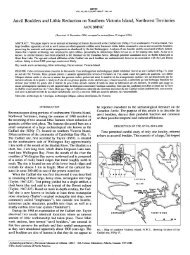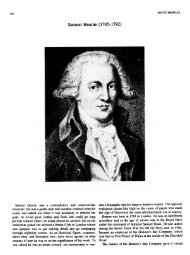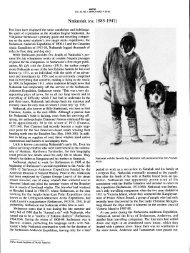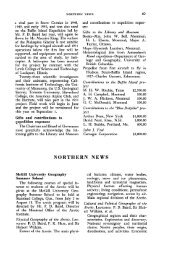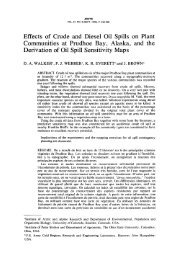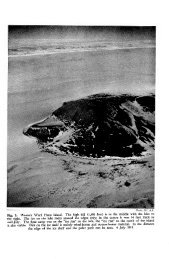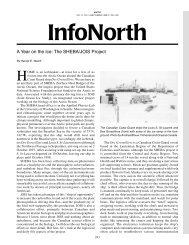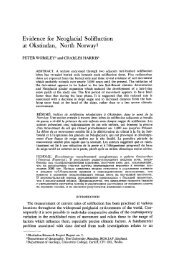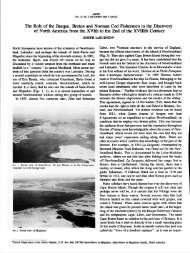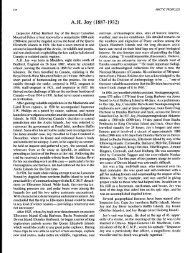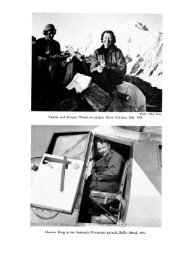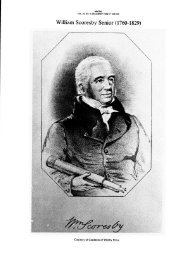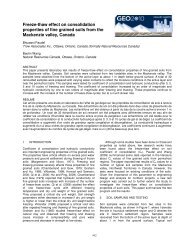To Make These Tribes Understand - AINA Publications Server
To Make These Tribes Understand - AINA Publications Server
To Make These Tribes Understand - AINA Publications Server
Create successful ePaper yourself
Turn your PDF publications into a flip-book with our unique Google optimized e-Paper software.
government’s purpose was to demonstrate to the Canadian<br />
public as a whole, as well as to the world, that the old laissezfaire<br />
attitude towards the North had ended and a new activist<br />
era had begun. It is significant that the trials of Alikomiak and<br />
Tatamigana took place at a time when the government was<br />
busily involved in establishing police posts in a number of<br />
remote spots in the Arctic for the purpose of demonstrating<br />
sovereignty, the basis for which under international law was<br />
more than a little questionable. In some places, such as the<br />
Bache Peninsula on Ellesmere Island, there were no inhabitants<br />
at all, so the demonstrations of sovereignty were confined<br />
to operating a pro forma post office, but in the western<br />
Arctic, the case under discussion here provided the opportunity<br />
for an actual criminal trial, one of the best demonstrations<br />
of sovereignty possible.<br />
The assertion that these trials were show trials for southerners<br />
as much as or more than for the Inuit is further<br />
reinforced by the sentences themselves. Many people commented<br />
at the time and have commented since that it was<br />
wrong to hang men when they were in ignorance of Canadian<br />
law; this was the main point made by those who signed<br />
petitions asking for clemency—the convicted men were<br />
“simple,” “primitive,” “ignorant of the law,” and so forth. But<br />
after all, the punishment for killing among the Inuit was the<br />
same as it was in the Canadian criminal code. Inuit who killed<br />
their own people could expect to be killed in return, and<br />
murder and retribution were extremely common among the<br />
Copper Inuit of that era; Rasmussen described a “small snowhut<br />
camp of fifteen families … [containing] not a single<br />
grown man who had not been involved in a killing in some<br />
way or other” (Rasmussen, 1932:17). It was the proceedings,<br />
not the sentence, that were alien to the Inuit.<br />
In this regard, it is surely significant that several observers<br />
who knew the Inuit well had suggested that corporal punishment<br />
would be a more appropriate punishment than would<br />
hanging. Judge Dubuc and three bishops of the Anglican<br />
church, one of whom was present at the trial, recommended<br />
punishments—life imprisonment, bread and water, flogging—<br />
which would have seemed more terrible to the Inuit than<br />
hanging. Though Dubuc was admittedly no expert, at least<br />
two of these men knew the North very well at first hand, better<br />
apparently than the government did. At first glance their<br />
advice seems merciful. But these punishments were, as these<br />
men themselves said, a far more severe penalty from the Inuit<br />
point of view than was hanging. Execution was the usual Inuit<br />
way of punishing murder, but corporal punishment was not<br />
only unusual, but as all three murder cases had demonstrated,<br />
something that the Inuit feared and resented. Being taken<br />
from their country to an unknown place and never returned<br />
was even worse; indeed, one reason Alikomiak gave for<br />
shooting Doak was that he did not want to be taken to<br />
Herschel Island for trial. The bishops and the judge were thus<br />
not simply squeamish liberals balking at a couple of salutary<br />
executions, but were, on the contrary, suggesting culturally<br />
devastating punishments which might well have had the<br />
deterrent effect the government claimed it wanted. Knowing<br />
what we do about the Inuit attitude towards physical<br />
INUIT TRIAL AT HERSCHEL ISLAND • 229<br />
punishment and exile makes the bishops seem much less<br />
merciful, though much more aware of Inuit culture, than<br />
were outsiders.<br />
Why then did the government not accept the advice of the<br />
judge and the bishops and modify the punishment to something<br />
far more humiliating and perhaps more effective than<br />
hanging? Part of the reason must be that the trials were for<br />
southern consumption, and in the south a flogging followed<br />
by imprisonment at hard labour would have been seen as<br />
insufficiently harsh. The federal government had been sensitive<br />
ever since the Alaska boundary dispute of 1903 to the<br />
charge of being weak in upholding Canada’s authority in the<br />
North. By hanging Alikomiak and Tatamigana, it showed<br />
Canadians that it would brook no further violence from Inuit,<br />
and it demonstrated to foreigners that the government intended<br />
to be a strong force in the region.<br />
This case may be seen also as a precursor to the current<br />
practice of imposing culturally relevant and appropriate sentences<br />
in some criminal cases involving First Nations people,<br />
and to the use of sentencing circles in such cases. In 1923,<br />
well-informed Northerners suggested that hanging was the<br />
wrong penalty to impose on Alikomiak and Tatamigana, not<br />
because it was cruel (which was the theme of most of those<br />
who petitioned the government for mercy) but because, given<br />
the cultural context of the Inuit, it was not harsh enough, or<br />
was inappropriate. Given the fact that the trials were as much<br />
for southern as for northern consumption, this suggestion was<br />
not adopted, but the fact that it was made at all, and for the<br />
reason it was, is of considerable significance.<br />
REFERENCES<br />
BOCKSTOCE, J.R. 1977. Steam whaling in the western Arctic.<br />
New Bedford: Old Dartmouth Historical Society.<br />
CDSS. 1923. Canada, Department of the Secretary of State Papers,<br />
National Archives of Canada, Capital Case File No. 24861,<br />
1923, Report on capital case of Alikomiak and Tatamigana.<br />
CONDON, R.G. 1996. The northern Copper Inuit. <strong>To</strong>ronto:<br />
University of <strong>To</strong>ronto Press.<br />
CORY, T.L. 1922. Letter to O.S. Finnie, 12 September 1922,<br />
Northern Administration Branch Papers, National Archives of<br />
Canada, RG 85, v. 607, f. 2580.<br />
EBER, D.H. 1997. Images of justice: A legal history of the<br />
Northwest Territories as traced through the Yellowknife<br />
Courthouse collection of Inuit sculpture. Montreal: McGill-<br />
Queen’s University Press.<br />
GRENFELL, W. 1923. Letter to the Ottawa Citizen, 22 November<br />
1923.<br />
HARRING, S. 1989. The rich men of the country: Canadian law in<br />
the land of the Copper Inuit, 1914–1930. Ottawa Law Review<br />
21:1–64.<br />
MORRISON, W.R. 1985. Showing the flag: The Mounted Police<br />
and Canadian sovereignty in the North, 1894-1925.<br />
Vancouver: University of British Columbia Press.<br />
MOYLES, R.G. 1979. British law and Arctic men. Saskatoon:<br />
Western Producer Prairie Books.



